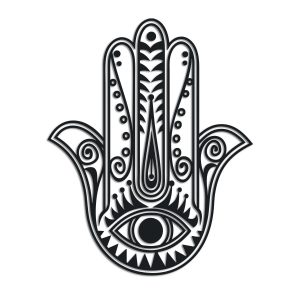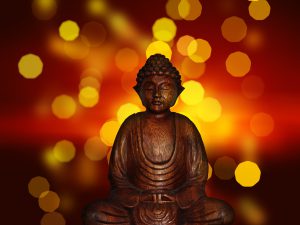7 Spiritual Symbols to Deepen Your Yoga & Meditation Practice

Symbols are a significant part of the yoga tradition and play an integral role in yoga practices. Although today many yoga practitioners overlook this aspect of yoga, we can still find traces of these symbols throughout the yoga journey.
Many mystics from India have stated that each individual comes into contact with a variety of universal forces when one practices yoga passionately and sincerely. This connection can be facilitated and expressed through the yoga symbols.
The symbols help the yoga practitioner achieve direct access to these forces, elevate themselves to a higher state of consciousness, develop positive qualities and bring deeper meaning and insight into one’s path. Hence, it becomes essential for each practitioner to know some of these common yoga symbols and their spiritual significance.
Understanding Seven Common Yoga Symbols and Their Spiritual Significance
1) Aum
Aum is the most common and sacred symbol within different spiritual traditions. Many yogis believe Aum to be the first uttered word. Considered to mirror the sound of the cosmos, chanting Aum helps us open our third eye and connect to the absolute and divine force of the universe. It allows us to tune in to a deeper place inside of us and create a clear vision of reality, one that lies beyond the conditioned mind. In practice, Aum is often used to open or close a yoga asana or meditation class. A powerful technique is to spend an entire meditation chanting Aum out loud and then mentally. This meditation will bring you tranquility, peace and bliss.
2) Lotus Flower
The traditional symbol for yoga is often the lotus flower or water lily. Buddhists consider the petals to depict the opening of the heart. The flower represents our ability to come from a place of suffering into the light, much like the lotus, whose roots start in the muddy earth and rise up through the water to the light of the sun. This reminds us that we too can rise up from any difficult situation and reconnect to the light that surrounds us. The lotus asana is one of the best for meditation as it increases concentration. However, it is advised to work slowly towards the full pose, starting out with half lotus, as it can be strenuous on the knees and hip joints.
3) Hamsa & Evil Eye
The hamsa and evil eye are found in many traditions, including yoga and Hinduism. The term “hamsa” refers to the five fingers and is drawn as a right hand with an open palm. The hamsa symbol is considered to bring luck, strength and protection. Many people even combine it with the evil eye symbol to counteract harmful effects. In yoga, and many other traditions, the evil eye represents the threat of jealous and malevolent stares that can be harmful to one’s health, property and prosperity. The hamsa and evil eye symbols can be worn as a talisman or hung above your front door.
4) Mandala
The literal meaning of mandala in Sanskrit is “circle”, and it is often used to represent the universe, circle of life and patterns of nature. In yoga, the mandala symbolizes unity and harmony of the mind, body and soul. A useful technique is to place or hang a mandala in front of you and focus your eyes on the center. This will help draw you deeper into concentration and meditation.
5) Buddha
The term Buddha means the “awakened one” and represents the founder of Buddhism. A real person, the Buddha was a former prince who gave up a lavish lifestyle to find the root of human suffering and discover the true meaning of life. His story inspires us to remember that as a normal person who liberated himself from suffering, we can do the same. It is recommended to take a moment at the beginning of a meditation to imagine yourself as Buddha with all of his qualities – open, enlightened and compassionate.
6) Chakras
Literally, “chakras” means “wheels”. However, in yoga, chakras are the centers of the energetic body or the aura. While we have many throughout the body, there are seven major chakras. Each has its own meaning, significance and responsibility for different physical, mental, emotional and spiritual aspects of our being. When an individual travels on the path of enlightenment, he/she must balance these seven chakras to achieve harmony and peace in his/her life. In yoga, each asana works to increase the flow of energy into a specific chakra and clear any negativities from it. Even simply focusing on the chakra location and visualizing its color will help us to clear and activate it.
7) Namaste
Namaste is a greeting in ancient Sanskrit that is still used in India and Nepal. In the yogic tradition, it is commonly used to welcome practitioners to a course and conclude the practice. It literally translates to mean the divine spirit within me recognizes and greets the divine spirit in you.
On the whole, those who practice yoga will benefit from understanding the meaning and spiritual significance of these yoga symbols. Further, incorporating them into your practice can deepen your connection to the spiritual world and maximize the benefits of yoga and meditation. At the same time, each individual can also create and add his/her own symbols based on personal experience and preference.
Like this article? Sign up to our newsletter to receive more!
Tag:chakras, Meditation, spirituality, Yoga










